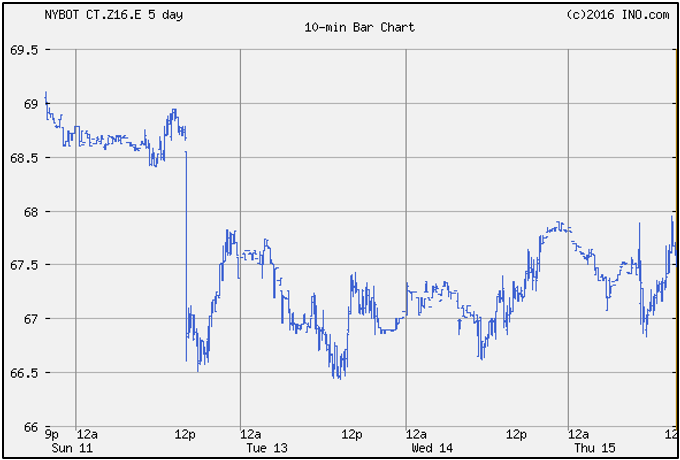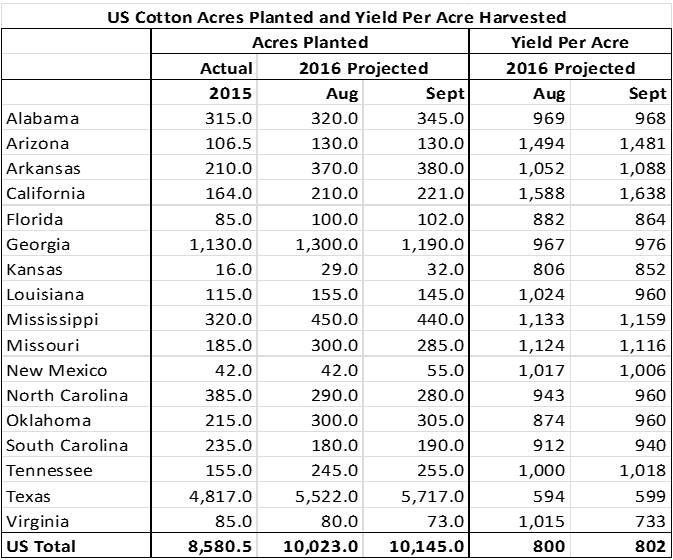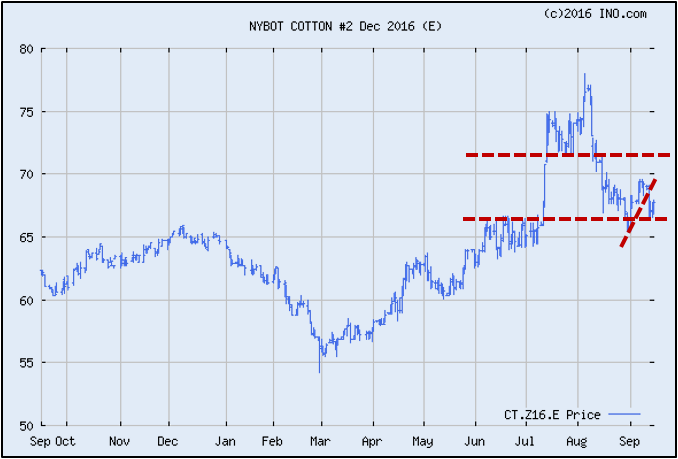 I’m not 100% sure what the cotton market expected to see in this week’s USDA monthly estimates. As if anyone ever knows. Whatever the market was expecting, it didn’t get it; prices reacted accordingly—down.
I’m not 100% sure what the cotton market expected to see in this week’s USDA monthly estimates. As if anyone ever knows. Whatever the market was expecting, it didn’t get it; prices reacted accordingly—down.
In the short term, markets and price direction are driven by expectations based on the data and information available at the time. Whatever price level that gives us in the interim, actual price at some point in the future will be higher or lower depending on how reality compares to expectations.
 Prices (December futures) were around the 69 cent area prior to Monday’s report. As soon as the report was out, prices dropped 2 cents. So, it’s probably safe to assume the market didn’t like the new numbers. Prices this week have ranged between a low of around 66½ and a high near 68 but have averaged about 1 ½ cents lower than prior to the report.
Prices (December futures) were around the 69 cent area prior to Monday’s report. As soon as the report was out, prices dropped 2 cents. So, it’s probably safe to assume the market didn’t like the new numbers. Prices this week have ranged between a low of around 66½ and a high near 68 but have averaged about 1 ½ cents lower than prior to the report.
The projected US crop was raised 260,000 bales to 16.14 million bales. This comes from an increase in both acres planted and acres harvested and a slight increase in yield. We found another net 122,000 acres planted. Among the largest changes, Texas was revised up 195,000 acres and Georgia was revised down 110,000 acres. Acreage in 10 of 17 states was revised up. US exports projected for the 2016 crop year were unchanged at 11.5 million bales. US textile mill use of cotton was lowered 100,000 bales from 3.6 to 3.5 million bales. US ending stocks for the 2016 crop marketing year were increased 200,000 bales to 4.9 million bales—the highest level since 2008 and a stocks-to-use ratio of 33%. I don’t see this as a present problem but we don’t need to start a trend of increasing stocks here in the US.
US exports projected for the 2016 crop year were unchanged at 11.5 million bales. US textile mill use of cotton was lowered 100,000 bales from 3.6 to 3.5 million bales. US ending stocks for the 2016 crop marketing year were increased 200,000 bales to 4.9 million bales—the highest level since 2008 and a stocks-to-use ratio of 33%. I don’t see this as a present problem but we don’t need to start a trend of increasing stocks here in the US.
Exports are projected at a relatively good level of 11.5 million bales. A larger US crop (and larger available supply) could eventually lead to further exports but this could be more difficult given the already good projection and given the reserve sales and import limit imposed by China.
The September report projects World cotton use/demand at 111.23 million bales—down just slightly from the August estimate—which was down from the July estimate. I believe the market wants to see this number growing, not flat or declining. We need to keep an eye on this is subsequent reports.
The India crop was reduced as expected. Turkey, Pakistan, and Australia crops were increased. Overall, World production was increased by almost 1 million bales from the August projection.
In somewhat of a surprise (at least to me), mill use in China remained at a projected 35 million bales and ending stocks essentially unchanged from August. China has extended its government reserve sales until the end of this month—expecting to meet increasing demand and reduce stocks even further. The September report does not reflect change in use or stocks. Future reports may make changes but it could be that the market was expecting to see some changes in the September numbers.
Where do we go from here? Prices were on somewhat of an uptrend prior to the September report. Prices had fallen to the 66 cent area but then rallied to near 69 cents prior to the report. The report broke the uptrend and took us back to the 67 cent neighborhood.
I believe many producers are protected at the 50% level with contracts or a combination of contracts and Put Options at 72 to 75 cents. I also know, however, that some producers are not and some have done little or nothing to date. The September report increased the US crop. I believe the crop is still a question mark. The China, India, and Pakistan crops are also yet uncertain. We also wait the effects of extended reserve sales in China. The US has a slightly larger crop than what was forecast a month ago and stocks have increased but this could all change with improved World use and exports.
The September report increased the US crop. I believe the crop is still a question mark. The China, India, and Pakistan crops are also yet uncertain. We also wait the effects of extended reserve sales in China. The US has a slightly larger crop than what was forecast a month ago and stocks have increased but this could all change with improved World use and exports.
Now “change” could be up or down. I’m just suggesting that there are scenarios that could give the grower another opportunity to take some marketing action. Prices are likely to stay in the 66-67 to 71-72 range. For growers who missed the last opportunities above 70 cents, another opportunity may await. But, likewise, 66 to 65 cents could be in our future if the US crop gets bigger and demand and exports don’t pick up.
—
—–
William Don Shurley, University of Georgia
229-386-3512 / donshur@uga.edu
- 2024 Average Farmland Rental Rates and Worker Wages Summary - December 20, 2024
- 40th Annual Beef Cattle Conference & Trade Show – February 12 - December 20, 2024
- Friday Feature:Carol of the Carillon Bells at UF - December 20, 2024


